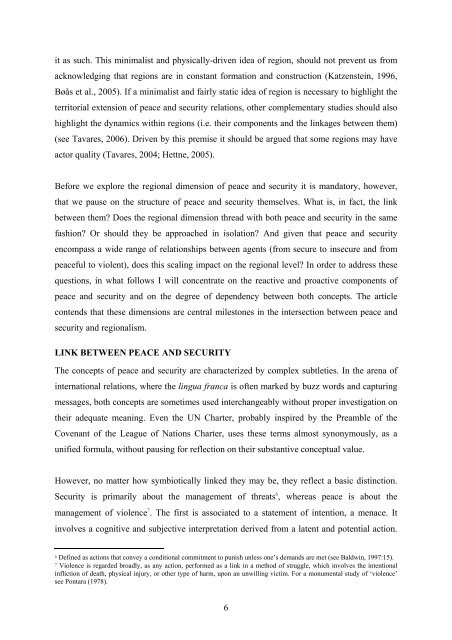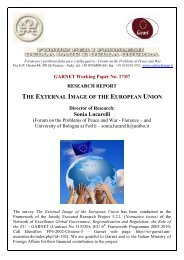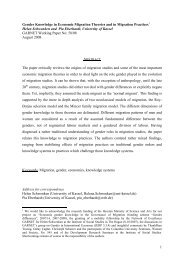GARNET Working Paper No. 13/07
GARNET Working Paper No. 13/07
GARNET Working Paper No. 13/07
You also want an ePaper? Increase the reach of your titles
YUMPU automatically turns print PDFs into web optimized ePapers that Google loves.
it as such. This minimalist and physically-driven idea of region, should not prevent us from<br />
acknowledging that regions are in constant formation and construction (Katzenstein, 1996,<br />
Bøås et al., 2005). If a minimalist and fairly static idea of region is necessary to highlight the<br />
territorial extension of peace and security relations, other complementary studies should also<br />
highlight the dynamics within regions (i.e. their components and the linkages between them)<br />
(see Tavares, 2006). Driven by this premise it should be argued that some regions may have<br />
actor quality (Tavares, 2004; Hettne, 2005).<br />
Before we explore the regional dimension of peace and security it is mandatory, however,<br />
that we pause on the structure of peace and security themselves. What is, in fact, the link<br />
between them Does the regional dimension thread with both peace and security in the same<br />
fashion Or should they be approached in isolation And given that peace and security<br />
encompass a wide range of relationships between agents (from secure to insecure and from<br />
peaceful to violent), does this scaling impact on the regional level In order to address these<br />
questions, in what follows I will concentrate on the reactive and proactive components of<br />
peace and security and on the degree of dependency between both concepts. The article<br />
contends that these dimensions are central milestones in the intersection between peace and<br />
security and regionalism.<br />
LINK BETWEEN PEACE AND SECURITY<br />
The concepts of peace and security are characterized by complex subtleties. In the arena of<br />
international relations, where the lingua franca is often marked by buzz words and capturing<br />
messages, both concepts are sometimes used interchangeably without proper investigation on<br />
their adequate meaning. Even the UN Charter, probably inspired by the Preamble of the<br />
Covenant of the League of Nations Charter, uses these terms almost synonymously, as a<br />
unified formula, without pausing for reflection on their substantive conceptual value.<br />
However, no matter how symbiotically linked they may be, they reflect a basic distinction.<br />
Security is primarily about the management of threats 6 , whereas peace is about the<br />
management of violence 7 . The first is associated to a statement of intention, a menace. It<br />
involves a cognitive and subjective interpretation derived from a latent and potential action.<br />
6 Defined as actions that convey a conditional commitment to punish unless one’s demands are met (see Baldwin, 1997:15).<br />
7 Violence is regarded broadly, as any action, performed as a link in a method of struggle, which involves the intentional<br />
infliction of death, physical injury, or other type of harm, upon an unwilling victim. For a monumental study of ‘violence’<br />
see Pontara (1978).<br />
6





